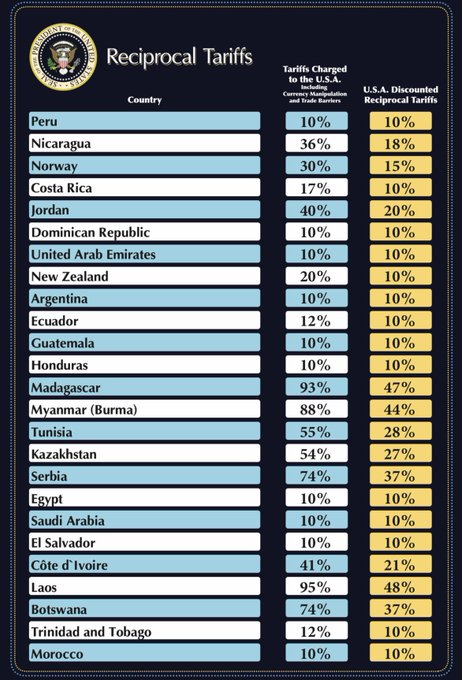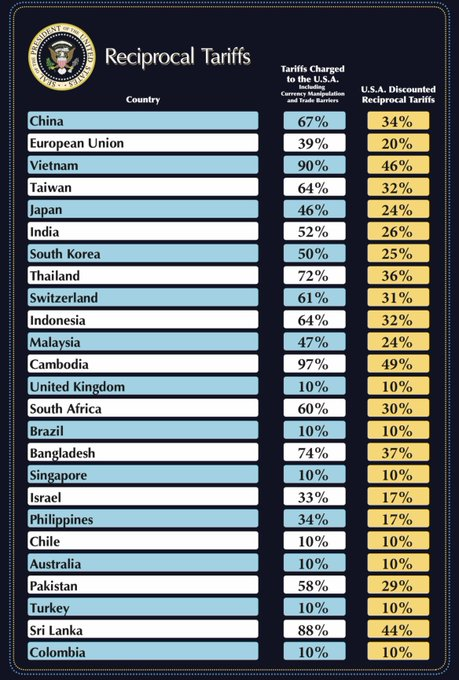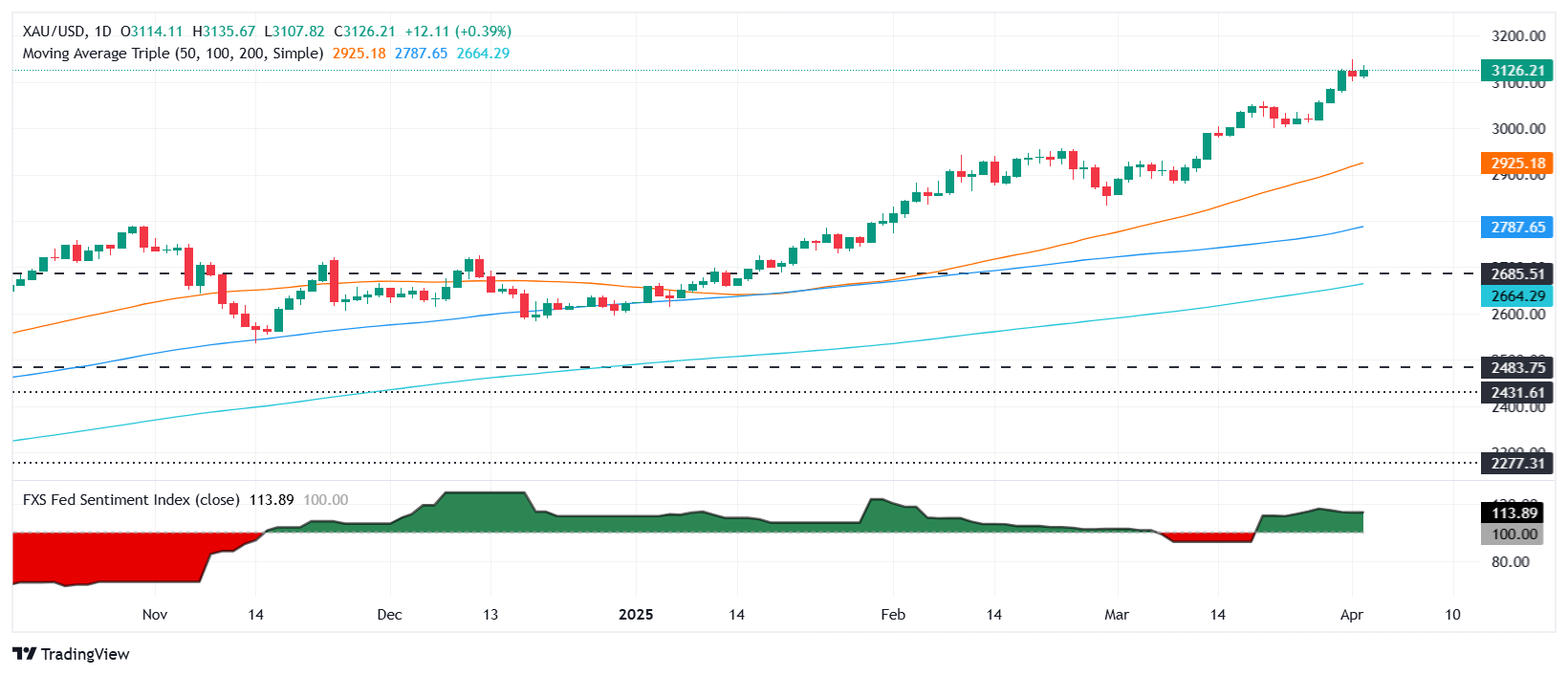- XAU/USD stable after 0.71% rally; Dollar weakness balances rising US yields amid global trade tensions.
- Trump announces new tariffs: 10% on all imports, 25% on autos, affecting China, EU, Vietnam, Japan, UK.
- Gold climbs 23% from November low, driven by safe-haven demand amid tariff uncertainty and a weakening Dollar.
- Economic data takes a backseat; market focus shifts to upcoming ISM Services PMI, NFP, and Powell’s speech for direction.
Gold price extended its gains on Wednesday, posting gains of 0.71%, yet as Thursday’s Asian session begins, the golden metal remains unchanged. At the time of writing, XAU/USD trades at $3,136, virtually unchanged.
US Liberation Day is finally here. US President Donald Trump announced that the US will impose 10% tariffs on all imports and 25% duties on automobiles. These duties become effective on April 3.
In addition, reciprocal tariffs are being imposed on selected countries

Additionally, he announced reciprocal tariffs would be applied to certain countries. China’s being hit with 34% duties, the European Union with 20%, 46% to Vietnam, 24% to Japan, and 10% to the United Kingdom.
Since US President Donald Trump won the election, Gold prices initially dipped before rallying and gaining over 23% from the November 14 low, when XAU/USD hit $2,536.
Bullion prices have extended their gains despite rising US yields. However, the broad weakness of the US Dollar (USD) kept Gold prices holding firm above the $3,100 mark.
US economic data has taken a backseat amid tariff jitters. ADP revealed that private companies hired more people than expected, while Factory Orders expanded above estimates but showed some signs of slowing down.
Ahead this week, traders are focusing on the ISM Services PMI for March, Nonfarm Payroll figures, and Fed Chair Jerome Powell's speech.
Daily digest market movers: Gold price edges up amid high US yields
- The US 10-year T-note yield rises three basis points to 4.19%. US real yields edge up three bps to 1.862%, according to US 10-year Treasury Inflation-Protected Securities (TIPS) yields.
- The ADP National Employment Report for March showed that businesses added 155K jobs, beating expectations of just over 105K and significantly higher than February’s 84K increase, signaling continued strength in private sector hiring.
- Meanwhile, Factory Orders rose 0.6% MoM in February, slightly above the 0.5% forecast, though slowing from January’s 1.8% surge.
- Looking ahead, Donald Trump is expected to announce reciprocal tariffs on US trading partners during an address in the White House Rose Garden, a move likely to stir market volatility and global trade tensions.
- The latest estimate from the Atlanta Fed's GDP Now model indicates that the GDP for Q1 2025 is expected to contract by 3.7%, down from the 2.8% estimate on March 28.
- Money market futures pricing in more than 73 basis points of interest rate cuts by the Federal Reserve (Fed).
XAU/USD technical outlook: Gold price retreats from all-time highs near $3,150
The uptrend in Gold prices remains intact; however, buyers' lack of commitment to push prices to record highs keeps the yellow metal trading sideways. The Relative Strength Index (RSI) is above the 70 level, indicating overbought territory. Traders should note that, due to the strength of the trend, the most extreme reading can reach 80. Therefore, further upside is anticipated.
If XAU/USD stays above $3,100, buyers maintain control. An extension of the rally would trigger a breach of the record high at $3,149, followed by the $3,200 mark. Conversely, a drop below $3,100 would expose the March 20 high, which has since become support at $3,057, followed by the $3,000 mark.
Tariffs FAQs
Tariffs are customs duties levied on certain merchandise imports or a category of products. Tariffs are designed to help local producers and manufacturers be more competitive in the market by providing a price advantage over similar goods that can be imported. Tariffs are widely used as tools of protectionism, along with trade barriers and import quotas.
Although tariffs and taxes both generate government revenue to fund public goods and services, they have several distinctions. Tariffs are prepaid at the port of entry, while taxes are paid at the time of purchase. Taxes are imposed on individual taxpayers and businesses, while tariffs are paid by importers.
There are two schools of thought among economists regarding the usage of tariffs. While some argue that tariffs are necessary to protect domestic industries and address trade imbalances, others see them as a harmful tool that could potentially drive prices higher over the long term and lead to a damaging trade war by encouraging tit-for-tat tariffs.
During the run-up to the presidential election in November 2024, Donald Trump made it clear that he intends to use tariffs to support the US economy and American producers. In 2024, Mexico, China and Canada accounted for 42% of total US imports. In this period, Mexico stood out as the top exporter with $466.6 billion, according to the US Census Bureau. Hence, Trump wants to focus on these three nations when imposing tariffs. He also plans to use the revenue generated through tariffs to lower personal income taxes.
Information on these pages contains forward-looking statements that involve risks and uncertainties. Markets and instruments profiled on this page are for informational purposes only and should not in any way come across as a recommendation to buy or sell in these assets. You should do your own thorough research before making any investment decisions. FXStreet does not in any way guarantee that this information is free from mistakes, errors, or material misstatements. It also does not guarantee that this information is of a timely nature. Investing in Open Markets involves a great deal of risk, including the loss of all or a portion of your investment, as well as emotional distress. All risks, losses and costs associated with investing, including total loss of principal, are your responsibility. The views and opinions expressed in this article are those of the authors and do not necessarily reflect the official policy or position of FXStreet nor its advertisers. The author will not be held responsible for information that is found at the end of links posted on this page.
If not otherwise explicitly mentioned in the body of the article, at the time of writing, the author has no position in any stock mentioned in this article and no business relationship with any company mentioned. The author has not received compensation for writing this article, other than from FXStreet.
FXStreet and the author do not provide personalized recommendations. The author makes no representations as to the accuracy, completeness, or suitability of this information. FXStreet and the author will not be liable for any errors, omissions or any losses, injuries or damages arising from this information and its display or use. Errors and omissions excepted.
The author and FXStreet are not registered investment advisors and nothing in this article is intended to be investment advice.
Recommended content
Editors’ Picks

Gold hovers around all-time highs near $3,250
Gold is holding steady near the $3,250 mark, fuelled by robust safe-haven demand, trade war concerns, and a softer-than-expected US inflation gauge. The US Dollar keeps trading with heavy losses around three-year lows.

EUR/USD retreats towards 1.1300 as Wall Street shrugs off trade war headlines
The EUR/USD pair retreated further from its recent multi-month peak at 1.1473 and trades around the 1.1300 mark. Wall Street manages to advance ahead of the weekly close, despite escalating tensions between Washington and Beijing and mounting fears of a US recession. Profit-taking ahead of the close also weighs on the pair.

GBP/USD trims gains, recedes to the 1.3050 zone
GBP/USD now gives away part of the earlier advance to fresh highs near 1.3150. Meanwhile, the US Dollar remains offered amid escalating China-US trade tensions, recession fears in the US, and softer-than-expected US Producer Price data.

Bitcoin, Ethereum, Dogecoin and Cardano stabilze – Why crypto is in limbo
Bitcoin, Ethereum, Dogecoin and Cardano stabilize on Friday as crypto market capitalization steadies around $2.69 trillion. Crypto traders are recovering from the swing in token prices and the Monday bloodbath.

Is a recession looming?
Wall Street skyrockets after Trump announces tariff delay. But gains remain limited as Trade War with China continues. Recession odds have eased, but investors remain fearful. The worst may not be over, deeper market wounds still possible.

The Best brokers to trade EUR/USD
SPONSORED Discover the top brokers for trading EUR/USD in 2025. Our list features brokers with competitive spreads, fast execution, and powerful platforms. Whether you're a beginner or an expert, find the right partner to navigate the dynamic Forex market.





